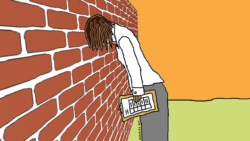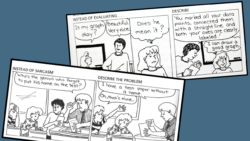
All teachers need to put their students on pause from time to time. Is it possible to do this without sacrificing learning?
Every day when I pick up my kids from school, I ask them what they did that day. Far too often, and especially near the end of last school year, I’d get this answer: “Watched a movie.”
Really? I’d say. Again?
My kids are 6, 7, and 8. I know that at this age, the chances are slim that their reporting is totally accurate, but still. It’s getting to the point where it’s every day. If they’re just going to watch movies all the time, I could do that with them at home. So why do I bother getting them up in the morning, hustling them to school on time, keeping their attendance records as clean as possible, only to have them plop on the carpet in front of the ActivBoard and watch Despicable Me for the fifteenth time? Okay, that’s an exaggeration. But that’s how it feels.
And then I think back to when I had my own classroom, when the file of papers that needed grading would bust at the seams. When the email came, reminding me of an IEP meeting I’d completely forgotten about, robbing me of my planning period yet again. A folder would land on my desk, requesting four days of class work for a sick student—and it needed to be turned in by 2:30 that day. Plans were due. Important e-mails were sliding off the visible screen of my inbox, where they would no longer get my attention. I needed a catch-up day. Bad.
And nothing worked quite as well as a movie: They would all sit at their desks, mesmerized and silent, while I plowed through my work, grading and sorting and putting everything in its place. And because I was in a middle school, I repeated this process in every class period. So with every passing hour, I found my blood pressure lowering and my love of the job returning. And at the end of the day, I could see the top of my desk, my lessons were planned weeks in advance, and I was refreshed and ready for the next day of teaching. Oh, and there was this: The day did not produce anything new to do. When my students left, I had no materials to put away, no fresh student work to respond to. It was the cleanest of slates. Plus, the kids thought I was awesome.
Now that I’m a parent, I definitely see things differently, and this article tells me I’m not alone. I do believe that if and when I go back to the classroom, I’ll be much more selective about the times when I use movies. And I’ll come up with other ways to create peace and quiet, some downtime in my room, when the kids can work independently and I can get organized. My guess is that it will involve silent reading: I’ll spend the first few weeks of school really working with them on independent reading, developing a system and creating an environment that will eventually reward me with some quiet time when I need it.
But there’s the rub: I’m not back in the classroom. I think I might suffer from the kind of amnesia that comes from elapsed time. I may have forgotten how desperate a teacher can become for a little extra time to get things done. And there’s this, too: As I write this post, all three of those precious children of mine have been placed in a technology coma, two on iPads, one watching a show. Despite my most lofty convictions of what’s right, I’m still doing it.
So I pose the question to you: How do you create downtime in class? How do you, if ever, put your students “on pause” in order to catch up on administrative tasks? Have you figured out how to make most or all of the time they spend in your class academically engaging? I think we can all agree that movies work fine on an occasional basis, but is it possible to rely too much on them? Are there more creative ways to keep kids minds engaged AND get a little time back for ourselves? Please share your ideas here so we can all learn together. ♦
To read some of the best solutions to this problem, check out John Spencer’s fantastic post, Twelve Creative Alternatives to Showing Movies Before the Break. And if you need a more big-picture solution to your time management issues, learn about the 40-Hour Teacher Workweek.
Join our mailing list and get weekly tips, tools, and inspiration that will make your teaching more effective and fun. You’ll get access to our members-only library of free downloads, including 20 Ways to Cut Your Grading Time in Half, the e-booklet that has helped thousands of teachers save time on grading. Over 50,000 teachers have already joined—come on in.





A few years ago our former principal asked that we not show any movies at all…especially a day before a break. Parents felt it was a waste of instructional time. I really do not agree with that, but I do try to follow orders most of the time! At first we were all in the typical, “How dare he”…etc., etc., but then we understood or could at least try to understand a parent’s perspective and of course there are some teachers who may have abused this activity. So, now we basically either show clips to make a point or create as a team, a special schedule to show an important movie that deals directly with our curriculum.
When I need time to “catch up” or conference with all my students “one on one” …I offer time for them to “catch up” as well. I think that 7th graders need to understand that there may be times when we ALL have to stop and get things in order. I chalk this up to teaching time management. I inform them a few days in advance and I offer choices. The choices include working on one of their long term projects, essay writing practice, one of their homework assignments or non fictional reading time. These times are infrequent, but when needed every one is appreciative and truly benefits.
As a fifth grade teacher in Virginia, we are not allowed to watch movies at all. At the beginning of the year, we do model and review silent reading but we are held accountable to being with the students at all times.
I think this subject is important because I find that I am burning myself out quickly.
This year, I plan to leave school no later than 5:00 in the afternoon. If something is left undone, so be it. I think I will be a much better teacher and person if I give myself time away from school.
I look forward to your next post.
Well, I’m not in the classroom anymore but when I was I too was guilty of the occasional movie. I did try to keep it content specific. I taught science so they sometimes watched Bill Nye. I love the silent independent reading time and the kids would too. However I really think that after awhile movies and reading time will lose its excitement and you will end up managing classroom problems instead of getting your paperwork done. I think the key is a variety of an independent tasks. I could get paperwork done If the students were taking notes from the textbooks. I guess that was guided reading??? Maybe we should make a list of other low maintenance activities that teachers could use. : )
I think the key for me was choosing one thing that really irked me and figuring out how to fix it. I hated questions about missed work, so I made a binder of hand-outs and notes pages and the dates we completed them, The students just had to look up the date, find the title of the hand-out or notes, and take them out. I didn’t feel like grading work every day, so I made the kids turn in work packets with cover sheets every Friday. I found it was much easier to grade all that work in my pajamas on Saturday morning than to struggle for it all week. The changes happened slowly and I had to try a few different approaches, but overall it saved me time and stress!
This is a great idea! I’m still trying to figure out ways to handle the missed work, and having a binder like this sounds like this will work for me. Thanks!
Watch, Think, Color. I discovered it on Teachers Pay Teachers two years ago and my kids LOVE it. It is for math, and serves as a great review. Basically, it keeps them quiet and focused while I get other things done.
Its a Power Point presentation on a timer. You can fuss with the timer if you know they will need more time per slide. Each slide has some sort of math problem. let’s say you picked 10 More 10 Less. So, the presentation will direct the kids to get some crayons ready (you need an orange and yellow crayon.) I tell the students they must be totally silent, no whispering, talking, or sharing answers or it gets turned off. Then I press GO, and I have 30-45 mins of Me Time.
The first slide will say something like “Color it Orange. 37+10” When they figure out that 37+10 is 47, they color it orange. The goal is that at the end they make a picture by coloring in the answers. They have all kinds, from place value, time, fractions, division, multiplication, etc. Its also great for me to see who got the picture right. I remember I did it before I started my fractions unit last year to see who knew them well enough to make the picture.
Sometimes we will watch Bill Nye or Magic Schoolbus and do a 3-2-1 activity after. But Watch, Think, Color is my go-to because I can have stacks of the coloring sheets always ready to go at any time.
p.s. I only do full length movies when the whole class earns them on Dojo. So, maybe 4 a school year.
That is a GREAT resource! I will look it up!
Hi Everyone! Each day after lunch we have a 10-12 minute quiet time in our third grade classrooms. Here’s the anchor chart we created with students:
Purpose: To rest, relax, and slow
down after a busy morning, which will help us be ready for an afternoon of learning
During 10 minutes of quiet time
we can:
– Quickly and calmly find our own space to rest
- Settle into a spot & get comfortable
- Read, write, draw, or rest
silently & independently
- Stay in our spot until it’s time to transition
In Kindergarten, we have a lot of one-on-one assessments to give students (counting, reading, etc.) – One thing I’ve learned from a teacher at my school is to do 10 centers. 2 students per center, so it stays really quiet and you can do as many rotations a day as you’d like (I stick to 15 minutes max per rotation). I usually do this as a math review at the end of a unit so I can pull students over to get each assessment accomplished. I’ve also done a cross-curriculur review at the end of the year, bringing back student favorites of centers from throughout the year.
I often use stem challenges. The kids are busy working, and I can get some stuff done in the room while they have to get creative! Noodle towers, index card houses, foil boats, etc. Kids are always engaged!
Do you have a go to site or book that you get those STEM challenges from?
As a first grade teacher, movies have been a successful tool in providing precious time to stay afloat. But, if I’m being honest I sometimes felt guilty using this technique. So I did a little research and found my new go to, STEAM tubs. I prepared plastic containers with a laminated task card and materials. I spent about a week at the beginning of the year teaching my students the correct ways to use the tubs and the correct procedure for clean up. I have a wide variety a task cards that I rotate frequently. When the students see the tubs they squeal with excitement and statements of, “You’re the greatest teacher ever!” I never received that kind of reaction when I turned on a movie!
Listening and gathering information from audio texts are important 21st century literacy skills. I have my students take notes on Ted Talks, Crash Course videos, or podcasts. The information is usually used for a discussion, debate, or persuasive writing prompt at a later day, so sometimes I even play the audio text twice for students to get the notes they’ll need. I also always have an independent reading project, with a final assignment such as a book talk and/or journaling, so I often start the week with Monday reading time. I actually have high school students who ask for reading time! The key for me is modeling for a bit before I start my own work, setting a time frame (you’ll read for 20 minutes, I’ll play this audio twice, etc) so kids know what to expect, and #1 tying it to a project.
Thanks for starting the discussion!
I keep a project going called genius hour. If ever a student finishes early, genius hour. Every Friday? We do genius hour. There are days I work very closely with the students and there are days I tell them I’m giving them breathing room to get their work done.
Genius hour/passion project/ 20 time is a student selected project – they can research anything, and yes, I mean anything. I have had kids learn to cars throw whereas others have written scholarly articles on Vladimir Putin. The point of the project is to show students that learning is fun and learning is a process. It’s the journey, not the end result. Students are graded on their process- response to setbacks, their Grit, honesty, etc.
I teach at a K-12 independent school in British Columbia. We started genius hour at our school for grades 4-6 when my daughter was in Grade 6. She is now in grade 10, and the difference between the Grade 10 and the Grade 11 & 12 classes is astounding in their ability to think creatively and critically, to seek out information in unlikely places, and their overall curiousity in every subject. Our 4-6 teachers often worry that Genius Hour is lost time in the classroom because not much is being produced, but I believe that the process of learning, and playing with their learning, results in far more engaged students.
So keep going. You may not get to see the long-term effect on your students but it is definitely there.
My grade level (K) use table top bins ( 1 bin for each table of four) with a variety of materials, such as craft stocks, paper plates. clothes pins. The table mates quietly use supplies to create anything they wish. We use this 20 minute block to do daily intervention. Kids are super quiet and engaged. Projects and materials are always open ended. When “Fine Motor Bin Time” is signaled to end they quietly disassemble projects and place all materials back into the tubs. I am using 12X 12 scrap booking bins this year. We rotate materials all year but most tubs last 3 months. Each day tables get a new tub, so it takes 5 days to rotate through all of our available bins.
When I need to conference with a dozen or so kids about on-going writing projects (I teach sophomores), I give my class a poster project to work on. It allows them to get creative with the materials we’re covering, it gives me something to put on the walls, and it’s an assignment that few kids will have questions about. As they’re busy finding ways to visually represent an idea or plot details or character traits, I can have certain kids meet me at my desk, and I have a couple minutes of uninterrupted instruction time with them.
Sustained Silent Reading.
We want students to read more. They are supposed to become better readers and writers. The solution? Students need opportunities to read. They need to be given time to read. Books of their choice. In silence.
Let students read.
I love to do a station rotation that students that students have already mastered. You can do 5 or 6 rotations, one every 15 minutes or 20 minutes. One can be art with watercolor, one might be a math software, one could be partner reading a social studies article, one can be “choice time” where students pick between 5 less academic activities, and finally a game center practicing punctuation. I did this every Friday when teaching grade 4, and got a lot done without showing a movie.